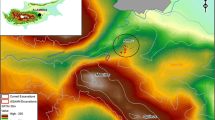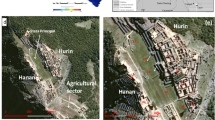Abstract
The ITACA Mission of the CNR, in collaboration with the University of Warsaw and the PIAISHM from 2017 to 2019, conducted for the first time in Machu Picchu an interdisciplinary survey project aimed at exploring the subsoil for archaeological purposes with remote sensing and geophysics. Excavations carried out by the PIAISHM in 2016 opened new questions to which the geophysical investigations have attempted to provide an answer. This chapter shows and discusses the results mainly based on georadar surveys, integrated in some cases with geomagnetic prospecting, that on the one hand have highlighted the effectiveness of the approach, on the other hand have brought to light information (albeit indirect, being geophysical anomalies) on the presence of potential buried structures, linked to human frequentation phases preceding the architectural evidences. The exploration of the subsoil made it possible to characterize the stratigraphy both for archaeological and geotechnical purposes, as in the case of the Principal temple, providing some useful data to understand the cause-and-effect mechanisms of the structural failure affecting the same temple.
Access this chapter
Tax calculation will be finalised at checkout
Purchases are for personal use only
Similar content being viewed by others
Notes
- 1.
The kancha is the Inca basic architectural unit characterized by a rectangular plan commonly composed of three walls; it is also a set of enclosures with three or more rectangular structures around the courtyard (Hyslop 1990, 17).
References
Aitken MJ, Webster G, Rees A (1958) Magnetic prospecting. Antiquity 32:270–271
Bastante JM (2016/2017) Los trabajos de las Expediciones Peruanas de Yale en la Llaqta de Machupicchu. Estudios Latinoamericanos 36/37:27–67
Bastante JM, Astete F, Fernandez A, Usca AI (2020) Estado de la cuestión: historia y arqueología de la llaqta de Machupicchu. In: Astete F, Bastante J (eds) Machupicchu Investigaciones Interdisciplinarias. Ministerio de Cultura del Peru, GD Impactos, Miraflores—Lima, vol I, pp 141–236
Bastante JM, Fernandez A, Astete F (2021) Machu Picchu: interdisciplinary researches. In this Book
Bingham H (1913) In the Wonderland of Peru. Natl Geogr 24:387–573
Bingham H (1922) Inca Land: explorations in the highlands of Peru, 2nd edn. Houghton Mifflin, Boston
Bonomo N, Osella A, Ratto N (2010) Detecting and mapping buried buildings with Ground-Penetrating Radar at an ancient village in northwestern Argentina. J Archaeol Sci 37:3247–3255
Campana S, Piro S (2009) Seeing the unseen—geophysics and landscape archaeology. CRC Press, London, UK, p 376. ISBN 978-0-415-44721-8
Canuti P, Fanti R, Margottini C, Spizzichino D (2008) Effects of landslides on Machu Picchu Cultural Heritage—Proceedings of The First World Landslide Forum 18–21 November, Tokyo, Japan, pp 411–416
Canuti P, Margottini C, Casagli N, Delmonaco G, Falconi L, Ferretti A, Lollino G, Puglisi C, Spizzichino D, Tarchi D (2009) Monitoring, geomorphological evolution and slope stability of Inca citadel of Machu Picchu: results from Italian Interfrasi Project. In: Sassa K, Canuti P (eds) Landslide—disaster risk reduction. Springer Verlag Berlin Heidelberg, 249–257 pp (978-3-540-699668)
Capozzoli L, Caputi A, De Martino G, Giampaolo V, Luongo R, Perciante F, Rizzo E (2015) Electrical and electromagnetic techniques applied to an archaeological framework reconstructed in laboratory, Advanced Ground Penetrating Radar (IWAGPR), 2015 8th International Workshop on Advanced Ground Penetrating Radar, IEEE, 7–10 July, Firenze. https://doi.org/10.1109/IWAGPR.2015.7292655
Capozzoli L, De Martino G, Capozzoli V, Duplouy A, Henning A, Rizzo E (2020a) The pre-Roman hilltop settlement of Monte Torretta di Pietragalla: first results of the geophysical survey. Archaeol Prospect. https://doi.org/10.1002/arp.1793
Capozzoli L, Catapano I, De Martino G, Gennarelli G, Ludeno G, Rizzo E, Soldovieri F, Uliano Scelza F, Zuchtriegel G (2020b) The discovery of a buried temple in Paestum: the advantages of the geophysical multi-sensor application. Remote Sens 12:2711
Carlotto V, Cárdenas JLF (2009) La geología, evolución geomorfológica y geodinámica externa de la ciudad inca de Machupicchu, Cusco-Perú. Revista de la Asociación Geológica Argentina 65(4):725–747
Catapano I, Gennarelli G, Ludeno G, Soldovieri F, Persico R (2019) Ground penetrating radar: operation principle and data processing. In: Wiley Encyclopedia of Electrical and Electronics Engineering. Wiley, Hoboken, NJ, pp 1–23
Fedi M, Cella F, Florio G, La Manna M, Paoletti V (2017) Geomagnetometry for Archaeology in Sensing the Past, Masini N, Soldovieri F (eds). Springer, Berlin/Heidelberg, Germany, pp 203–230
Gasparini G, Margolies L (1980) Inca Architecture. Indiana University Press
Goodman D (2017) GPR-SLICE v7.0 Ground Penetrating Radar Imaging Software
Henderson KK (2004) Ground-Penetrating Radar at Tiwanaku, Bolivia. Unpublished Master’s thesis. Department of Anthropology, University of Denver, Denver
Hyslop J (1990) Inka settlement planning. University of Texas Press, Austin, TX
Keay SJ, Parcak SH, Strutt KD (2014) High resolution space and ground-based remote sensing and implications for landscape archaeology: the case from Portus, Italy. J Archaeol Sci 52:277–292. https://doi.org/10.1016/j.jas.2014.08.010
Larson DO, Lipo CP, Ambos EL (2003) Application of advanced geophysical methods and engineering principles in an emerging scientific archaeology. First Break 21:51–62
Lasaponara R, Leucci G, Masini N, Persico R (2014) Investigating archaeological looting using satellite images and GEORADAR: the experience in Lambayeque in North Peru. J Archaeol Sci 42:216–230. https://doi.org/10.1016/j.jas.2013.10.032
Lasaponara R, Masini N, Pecci A, Perciante A, Pozzi Escot D, Rizzo E, Scavone M, Sileo M (2017) Qualitative evaluation of COSMO SkyMed in the detection of earthen archaeological remains: the case of Pachamacac (Peru). J Cult Herit. https://doi.org/10.1016/j.culher.2015.12.010
Lascano E, Osella A, de la Vega M, Buscaglia S, Senatore X, Lanata JL (2003) Geophysical prospection at Florida Blanca archaeological site, San Julián Bay, Argentina. Archaeol Prospect 10:175–192
Loke MH, Barker RD (1996) Rapid least-squares inversion of apparent resistivity pseudosections by a quasi-Newton method. Geophys Prospect 44:131–152
Loke M, Chambers J, Rucker D, Kuras O, Wilkinson P (2013) Recent developments in the direct-current geoelectrical imaging method. J Appl Geophys 95:135–156
Ludeno G, Capozzoli L, Rizzo E, Soldovieri F, Catapano I (2018) A microwave tomography strategy for underwater imaging via Ground Penetrating Radar. Remote Sens. https://doi.org/10.3390/rs10091410
Margottini C, Spizzichino D (2014) How Geology Shapes Human Settlements. In: Bandarin F, van Oers R (eds) Reconnecting the city. The historic urban landscape approach and the future of urban heritage. Wiley Blackwell, Chichester, vol 95, pp 135–156
Masini N, Capozzoli L, Chen P, Chen F, Romano G, Lu P, Tang P, Sileo M, Ge Q, Lasaponara R (2017) Towards an operational use of Remote Sensing in Archaeology in Henan (China): Archaeogeophysical investigations, approach and results in Kaifeng. Remote Sens 9:809. https://doi.org/10.3390/rs9080809
Masini N, Capozzoli L, Romano G, Sieczkowska D, Sileo M, Bastante J, Astete VF, Ziolkowski M, Lasaponara R (2018) Archaeogeophysical based approach for Inca archaeology: overview and one operational application. Surv Geophys. https://doi.org/10.1007/s10712-018-9502-2
Mazzoli S, Vitale S, Delmonaco G, Guerriero V, Margottini C, Spizzichino D (2009) Diffuse faulting in the Machu Picchu granitoid pluton, Eastern Cordillera, Perù. J Struct Geol 31:1395–1408. https://doi.org/10.1016/j.jsg.2009.08.010
Moseley ME (1992) The Incas and their ancestors: the archaeology of Peru. Thames and Hudson, New York
Piro S, Goodman D, Nishimura Y (2003) The study and characterization of Emperor Traiano’s Villa (Altopiani di Arcinazzo, Roma) using high-resolution integrated geophysical surveys. Archaeol Prospect 10:1–25
Piro S, Sambuelli L, Godio A, Taormina R (2007) Beyond image analysis in processing archaeomagnetic geophysical data: case studies of chamber tombs with dromos. Near Surface Geophysics 5(6):405–414
Pozzi-Escot D, Oshiro MDJ, Romano G, Lasaponara R, Capozzoli L, Masini N (2018) Traces in the desert: use of new technologies for conservation and study of the Pachacamac sanctuary—Lima, Peru, Heritage Science, https://doi.org/10.1186/s40494-018-0230-1
Prümers H (2006) Improntas de esteras en ceramica prehispanica del sitio Bella Vista (Depto. Beni, Bolivia) Actas III Jornadas Internacionales sobre Textiles Precolombinos. In: Solanilla Demestre V (ed) Departament d’Art de la Universitat Autonoma de Barcelona—Institut Catala Iberoamericana, Barcelona, pp 207–212
Reinhard J (1991) Machu Piccu. El Centro Sagrado, Instituto Machu Picchu, Cimagraf, Lima
Revil A, Karaoulis M, Johnson T, Kemna A (2012) Review: Some low-frequency electrical methods for subsurface characterization and monitoring in hydrogeology. Hydrogeol J 20
Rizzo E, Capozzoli L (2019) Integrated Geophysical Techniques for Archaeological Remains: Real Cases and Full Scale Laboratory Example, Chapter 13 in El-Qady G, Metwaly M (eds) Archaeogeophysics. Springer International Publishing AG, part of Springer Nature. https://doi.org/10.1007/978-3-319-78861-6_13
Spizzichino D (2012) Landslide risk assessment and management in the archaeological site of Machu Picchu Inca citadel (Peru). PhD thesis in Earth System Sciences: Environment, Resources and Cultural Heritage at University of Modena and Reggio Emilia (XXIII Cycle)
Spizzichino D, Margottini C, Puzzilli L (2013) Landslide risk assessment and management in the archaeological site of Machu Picchu (Peru). In: (a cura di): Bilotta E, Flora A, Lirer S, Viggiani C, Geotechnical Engineering for the Preservation of Monuments and Historic Sites. Taylor & Francis Group, London, ISBN: 978-1-138-00055-1, Napoli, 30–31 May 2013
Telford W, Geldart L, Sheriff R (1990) Applied Geophysics (2nd ed.). Cambridge University Press, Cambridge. https://doi.org/10.1017/CBO9781139167932
Wright KR, Kelly JM, Valencia Zegarra A (1997) Machu Picchu: ancient hydraulic engineering. J Hydr Engrg, ASCE 123(10):838
Ziółkowski M, Abuhadba JB, Hogg A, Sieczkowska D, Rakowski A, Pawlyta J, Manning SW (2020) When did the Incas build Machu Picchu and its satellite sites? New approaches based on radiocarbon dating. Radiocarbon 1–15. https://doi.org/10.1017/RDC.2020.79
Acknowledgements
The research was funded by the National Science Centre of Poland (grant OPUS nr UMO-2015/19/B/HS3/03557), the Italian National Research Council , and Italian Ministry of Foreign Affairs.
Author information
Authors and Affiliations
Corresponding author
Editor information
Editors and Affiliations
Rights and permissions
Copyright information
© 2022 The Author(s), under exclusive license to Springer Nature Switzerland AG
About this chapter
Cite this chapter
Capozzoli, L. et al. (2022). New Results from Archaeogeophysical Investigations in Machu Picchu. In: Ziółkowski, M., Masini, N., Bastante, J.M. (eds) Machu Picchu in Context. Springer, Cham. https://doi.org/10.1007/978-3-030-92766-0_7
Download citation
DOI: https://doi.org/10.1007/978-3-030-92766-0_7
Published:
Publisher Name: Springer, Cham
Print ISBN: 978-3-030-92765-3
Online ISBN: 978-3-030-92766-0
eBook Packages: Social SciencesSocial Sciences (R0)




